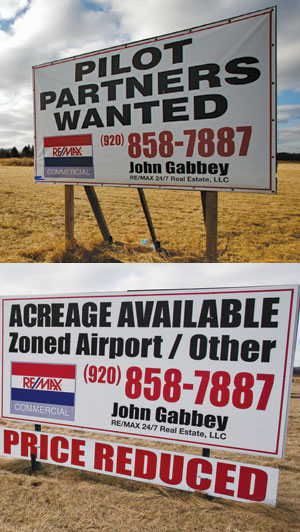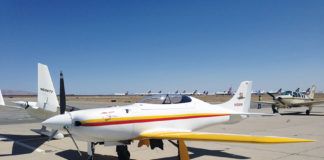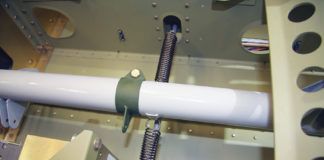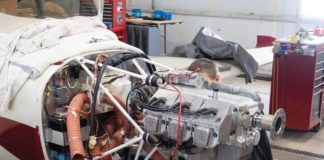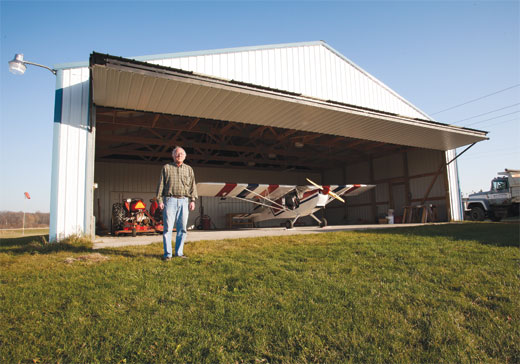
Jim Shy poses with his RANS S-7S.
During his long, peripatetic engineering career, Jim Shy once visited Washington, D.C. At the Jefferson Memorial he read the Declaration of Independence. The words of its second paragraph struck a chord, and he didn’t forget them: “We hold these truths to be self-evident, that all men are created equal, that they are endowed by their Creator with certain unalienable Rights, that among these are Life, Liberty and the pursuit of Happiness.”
One facet of Shy’s happy pursuit has been a childhood dream, alloyed with an engineer’s pragmatism, of building an airplane. “When you retire from work, you need something to do,” he said, his lanky frame comfortably perched on a tall stool next to one of his shop’s five Chapter 1000 standardized work tables. “Building an airplane was certainly something to do,” he continued, nodding his sun-browned head toward the trim white, red and blue RANS S-7S on the other side of the wall, and he did it for seven years.
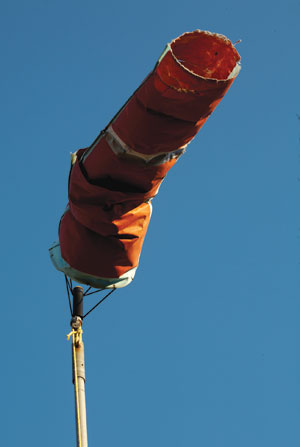
To make windsock replacement easy, Jim Shy built a pole that raises and lowers it like a flag.
Before he retired, and before he had even decided what airplane to build, Shy bought an airport. An instrument-rated commercial pilot, Sport Pilot privileges now satisfy his aeronautical needs. “It just seemed better to me to have a little strip and keep [an airplane] there rather than trying to find someplace to keep it at a big airport,” he explained. He considered a farm strip, but it was inefficient. “Most farm fields are square, or mostly square, so you end up buying too much land for a diagonal strip of any length.” Further, he didn’t know anything about the regulations (see sidebar on Page 28).
Shy and his wife, Alice, were married in 1963 and lived in Kansas City, where he worked for Lafarge, the world’s leading manufacturer of cement. When he retired, his wife wanted to be in Wisconsin to be close to their three daughters, who had gone to college, gotten married, and settled in the area when he worked for Allis-Chalmers in Milwaukee. Blue eyes twinkling behind silver-rimmed glasses, he said that all 13 grandchildren would be visiting for Thanksgiving, “So it’s going to be like, who let the monkeys out?”
Field Notes
In 1962, local pilots built an airport, incorporating it as Mid-Wisconsin Aviation, in Berlin, Wisconsin, a small town of 5300 located 20 miles west of Oshkosh. In 1999, when Shy read the ad offering Berlin Field (31WN) for sale, one pilot and one airplane remained. Assuming it was beyond his price range, Shy made a phone call. “It didn’t sound like terribly much, so I drove up there to look at it.” Its lone ramshackle structure was more shed than hangar, and Runway 9/27 was a narrow, undulating path chopped out of the weeds. “I wasn’t going to do any better,” Shy said. Covering 19 acres, “It’s long and skinny, like a bowling alley, 385 feet wide and a half-mile long.”
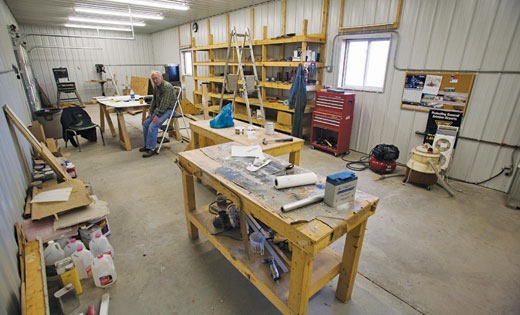
Shy in his hangar shop at Berlin Field.
To own the airport Shy had to buy the corporation, which he did in 1999. It fit his plan to be a consulting engineer when he retired in 2000, but Mid-Wisconsin Aviation was “inappropriate for the cement business,” he said, laughing. With the second paragraph of the Declaration of Independence in mind, he thought “there’s a 3M, so 2pDI should work.”
But it’s still Berlin Field. The runway is once again a long, skinny rectangle of crew-cut grass. Not counting the 300-foot displaced threshold that keeps western approaches above the traffic on State Highway 49, it is 55 feet wide, with mowable 2×8-foot white gravel dashes marking the width every 100 yards of the 1850-foot length. (Although the airport is private, Shy says pilots are welcome to fly in—if they call first for permission.) Cutting the grass takes a few hours, and Shy traded his lawn tractor for a red Massey Ferguson with a 7-foot finish mower behind its tall rear wheels.
Shy built the 50-foot-square hangar in 2002 by walling off and insulating the back two-fifths of his shop. He sold the original shed to Graydon Gray, who turned it into a snug hangar, a place to build an original design using parts from high-wing tandem taildraggers. Steve Marhle, an aeronautical cousin to Back to the Future’s Doc Brown, built his 50×80-foot hangar in 2004. It is crammed with flying machines, from a scaled Fieseler Storch and a disassembled Mitchell Wing to dozens of radio-control models, many with video cameras and birdlike camouflage. West of Marhle’s place, a pilot is building a 50×60-foot hangar for his fleet of ultralights. Pilots own their hangars, Shy says, and pay rent to 2pDI. “As far as I’m concerned, we can build hangars right down to the end of the runway.”
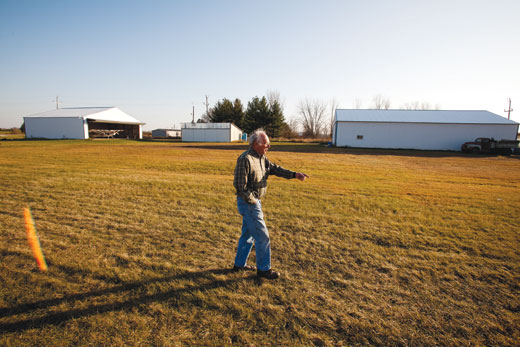
Pilots own their hangars but rent their spots on Berlin Field.
Boyhood Haunts Revisited
Berlin Field is not unlike Halley Field, a grass strip north and a little east of downtown Rapid City, South Dakota. Then on a gravel road a mile from Shy’s childhood home, it’s now covered by houses. A high school student who liked airplanes, Shy walked to work there as a line boy. “I didn’t make much, but they taught me to fly for free.” In a J-3 Cub, he earned his private ticket before graduating from high school in 1956. Studying mechanical engineering at the South Dakota School of Mines, he kept working and flying at Halley until he joined the Navy in 1958.
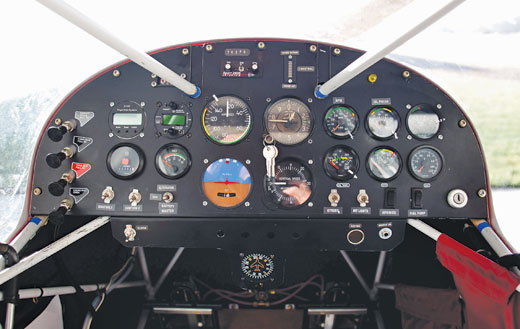
The panel serves Shy’s Sport Pilot needs.
Building a Resume
An aviation electronics technician, Jim Shy served in Cuba with VU-10, a utility squadron with B-26s and F-86s that towed aerial gunnery targets for ships and planes. “I flew in the back of a B-26 quite a bit.” He finished his hitch on the aircraft carrier USS Independence and returned to Rapid City to marry Alice, start a family and, in 1965, earn his degree.
Hired by Pratt & Whitney, and after 18 months of working on its SST engine, Shy decided it was too high-tech and got a job at Beechcraft in Wichita, Kansas, working on fuel systems. Flying once again, he earned his commercial ticket and instrument rating. Then Swearingen recruited him for its transonic jet project. The company killed the project on his first day in San Antonio, Texas, and put everyone on certification of the turboprop Metroliner. A year later, on the day it was certified, all of the engineers were fired.
Unable to find an aviation position during the recession in the 1970s, Shy joined Allis-Chalmers’ Mineral Systems Division and evolved into a process engineer. Laid off 16 years later, he got a job with Lafarge, which moved him around North America, and finally to Kansas City, where he worked on the construction of a new cement plant. Retiring in 2000, Shy built a home in Berlin, about a mile to the south of the airport he’d bought the previous year.
Finally Time To Start
Deciding what airplane to build took Shy three years. Sport Pilot requirements narrowed the field, and any candidate had to have straightforward construction, because he knew nothing about building airplanes. After visiting the RANS factory in Hays, Kansas, Shy settled on the S-7S because of its similarities to a Cub. He ordered a standard kit. “You’re supposed to be able to build it in a year, in 700 hours or something,” he said, but it took him seven years and about 3500 hours. Still, it seems clear that he found happiness on the learning curve.
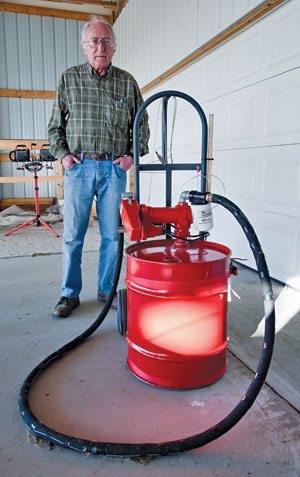
Shy fills his 20-gallon hand-truck fueler with 5-gallon cans hauled from the gas station.
Covering the airplane was the biggest challenge. It took two years, with winters off, “because I’d asphyxiate myself back here,” Shy said, sweeping a green plaid shirtsleeve to encompass the shop. Stepping through the Poly-Fiber process and coatings he applied with a high-volume, low-pressure sprayer, he said, “It seemed like I was painting silver forever.” To make masking less complicated, Shy’s scheme arranges simple sections of red and blue on the white airplane. The registration was easy: N762PD, for “1776, second paragraph of the Declaration of Independence.” The FAA doesn’t allow an I because it looks like a 1.
Aside from the occasional volunteer recruited to help move the big pieces, “I built the airplane myself,” Shy said. “The craftsmanship isn’t the best in the world, but what are you gonna do? If you’re an amateur, you’re an amateur.” Perhaps. He says he didn’t have to remake a part or order any replacements. A walk around the S-7 reveals no wrinkles, no runs and no visible errors. “I just kept working,” he said. When questions arose, he called RANS. “Sometimes I was on the phone to them three times a week. This one guy I talked to for years. I think they were happier than I was when the airplane got done.”
One answer was elusive. The kit included a 20×70-inch sheet of thin aluminum with no clear purpose. “So I kept building, figuring it would show up in the book.” It was still on the shelf when Shy finished the S-7 in July 2010, so he called RANS one more time. Puzzled as well, RANS discovered a long errant decimal point on what was supposed to be 2×7-inch sheet of wingstrut shim stock. Shy wondered what that had cost the company. The irony is that his struts didn’t need shims. Shy’s only changes to the kit were gas struts to hold open the swing-up doors, and fuses, because he just thinks they’re better than circuit breakers.
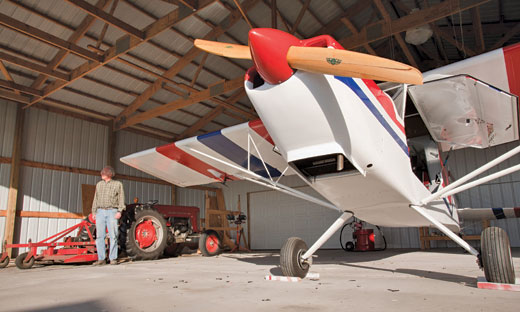
A Massey Ferguson tractor with a 7-foot finish mower shares the hangar with Shy’s RANS S-7S.
Time In Type
Four decades since his last flight, and with only 5 hours in a taildragger like the S-7, Shy knew it was time to brush up his flying skills. The good news was Plane Guys Aviation. An hour’s drive north, at Waupaca Municipal Airport (KPCZ), PGA offered training in an LSA-certified S-7. The bad news? “I couldn’t remember anything, I couldn’t do anything. It was like starting over,” Shy said. “I’ve decided that 52 years is too long to lay off flying a taildragger.” Given his slow progress, Shy asked his instructor, Richard Merkley, to make the first flight in the plane he’d completed. Shy figured that with several hundred hours in the S-7, Merkley would be able to handle it if something went wrong.
The first flight’s only problem was an incommunicative Microair radio. Shy suspected the antenna but discovered that the intercom was knocking down the radio’s audio. He pulled the intercom and sent it home to Sigtronics, which brought some circuits up to date. This fixed the audio problem, Shy says, but further testing is needed to determine if that also applies when transmitting.
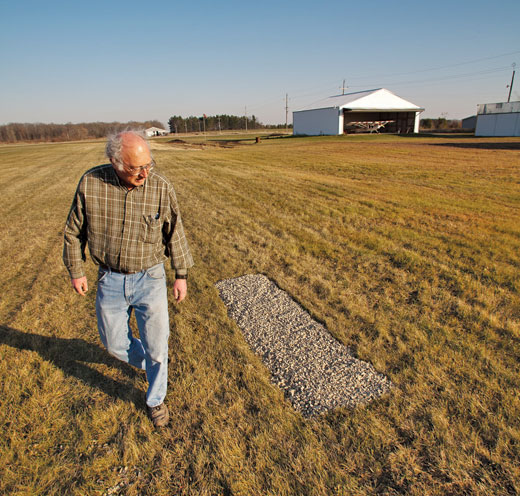
White gravel strips mark the sides of the runway without impeding the mower’s path or progress.
With no plans to keep the runway free of snow, Shy resumed his transition training and made his first flight last summer; he has logged 32 hours in a series of short, enjoyable flights. To easily refuel his S-7 with mogas, he strapped a red 20-gallon barrel to a hand truck and accessorized it with a ground wire, battery-powered pump, and fuel hose and nozzle. And to make windsock replacement easy, he built a pole that raises it like a flag. Completing the 40-hour test phase is next on his list of things to do, and he’s looking forward to it. “I’ll be up flying again next summer,” he said confidently, “at least that’s the plan. Once I get going, I’ll fly every day.”
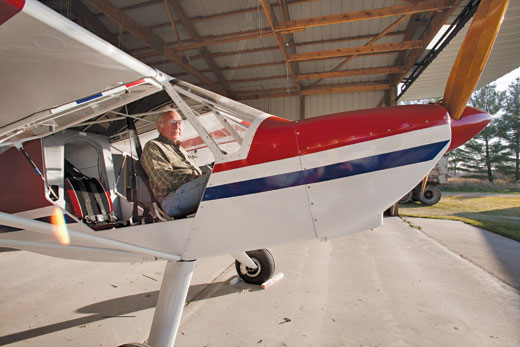
Shy awaits further pursuits of happiness in N762DP.

